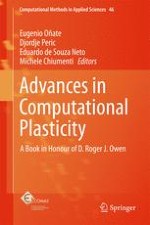2018 | Buch
Advances in Computational Plasticity
A Book in Honour of D. Roger J. Owen
herausgegeben von: Eugenio Oñate, Djordje Peric, Eduardo de Souza Neto, Michele Chiumenti
Verlag: Springer International Publishing
Buchreihe : Computational Methods in Applied Sciences
